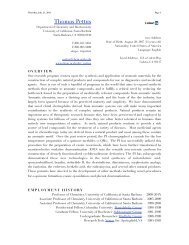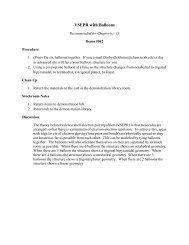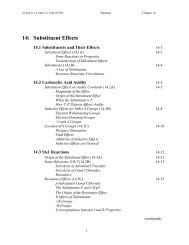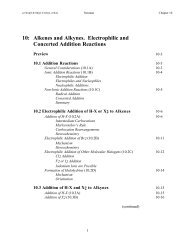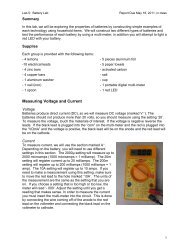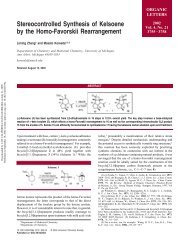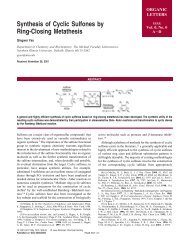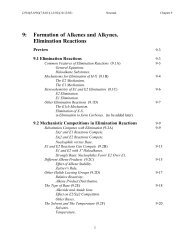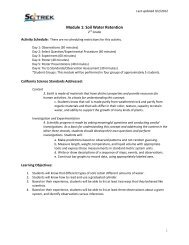Pyrophoric Liquid Reagents - UCLA Chemistry and Biochemistry
Pyrophoric Liquid Reagents - UCLA Chemistry and Biochemistry
Pyrophoric Liquid Reagents - UCLA Chemistry and Biochemistry
You also want an ePaper? Increase the reach of your titles
YUMPU automatically turns print PDFs into web optimized ePapers that Google loves.
<strong>UCLA</strong> <strong>Chemistry</strong> & <strong>Biochemistry</strong><br />
Procedures for Safe Use of <strong>Pyrophoric</strong> <strong>Liquid</strong> <strong>Reagents</strong><br />
Researchers should not use pyrophoric reagents until they have read <strong>and</strong> fully understood these safe<br />
operating procedures. However, reading these procedures does not substitute for h<strong>and</strong>s-on training.<br />
New users of pyrophoric reagents must work under the close supervision of an experienced user.<br />
I. Scope<br />
A variety of liquid reagents are pyrophoric (spontaneously ignite in air) including (but not necessarily<br />
limited to):<br />
Alkyllithium reagents (Typically in hydrocarbon solvents) (Tert-butyllithium is VERY pyrophoric)<br />
Alkenyllithium <strong>and</strong> Aryllithium reagents (Typically in hydrocarbon solvents)<br />
Alkynyllithium reagents (Typically in hydrocarbon solvents)<br />
Grignard <strong>Reagents</strong> (RMgX) (Typically in hydrocarbon solvents)<br />
Alkylaluminum reagents (Neat or in hydrocarbon solvents) (Neat reagents are VERY pyrophoric)<br />
Alkylzinc reagents (Neat reagents are pyrophoric)<br />
Boranes (Neat reagents are pyrophoric)<br />
II. Hazards<br />
In general these materials are pyrophoric; they ignite spontaneously when exposed to air. They also<br />
tend to be associated with flammable solvents. Other common hazards include corrositivity, water<br />
reactivity, peroxide formation, toxicity, <strong>and</strong> damage to the liver, kidneys, <strong>and</strong> central nervous system.<br />
III. Controlling the Hazards<br />
BEFORE working with pyrophoric reagents, read the relevant Material Safety Data Sheets (MSDS) <strong>and</strong><br />
underst<strong>and</strong> the hazards. The MSDS must be reviewed before using an unfamiliar chemical <strong>and</strong><br />
periodically as a reminder.<br />
Set up your work in a laboratory fume hood or glove box <strong>and</strong> ALWAYS wear the appropriate PPE<br />
Personal Protective Equipment (PPE)<br />
Eye Protection<br />
• Chemical Splash goggles or safety glasses that meet the ANSI Z.87.1 1989 st<strong>and</strong>ard must be worn<br />
whenever h<strong>and</strong>ling pyrophoric chemicals. Ordinary prescription glasses will NOT provide adequate<br />
protection unless they also meet this st<strong>and</strong>ard. When there is the potential for splashes, goggles<br />
must be worn, <strong>and</strong> when appropriate, a face shield added.<br />
• A face shield is required any time there is a risk of explosion, large splash hazard or a highly<br />
exothermic reaction. All manipulations of pyrophoric chemicals which pose this risk should occur in<br />
a fume hood with the sash in the lowest feasible position. Portable shields, which provide protection<br />
to all laboratory occupants, are acceptable.<br />
Skin Protection<br />
• Gloves must be worn when h<strong>and</strong>ling pyrophoric chemicals. Nitrile gloves should be adequate for<br />
h<strong>and</strong>ling most of these in general laboratory settings but they are combustible. Use adequate<br />
protection to prevent skin exposures. Heavy gloves are required for work with large quantities.<br />
• A fire resistant lab coat must be worn.<br />
• A chemical-resistant apron worn over the lab coat is required for working with large quantities.<br />
• No open toe shoes are allowed.<br />
IV. Designated Work Area<br />
Procedures for Safe Use of <strong>Pyrophoric</strong> <strong>Liquid</strong> <strong>Reagents</strong>, 2/2009 Page 1 of 5
<strong>UCLA</strong> <strong>Chemistry</strong> & <strong>Biochemistry</strong><br />
Eyewash<br />
• Suitable facilities for quick drenching or flushing of the eyes should be within 10 seconds travel time<br />
for immediate emergency use. Bottle type eyewash stations are not acceptable.<br />
Safety Shower<br />
• A safety or drench shower should be available within 10 seconds travel time where pyrophoric<br />
chemicals are used.<br />
Fume Hood<br />
• Many pyrophoric chemicals release noxious or flammable gases <strong>and</strong> should be h<strong>and</strong>led in a<br />
laboratory hood. In addition, some pyrophoric materials are stored under kerosene (or other<br />
flammable solvent), therefore the use of a fume hood (or glove box) is required to prevent the<br />
release of flammable vapors into the laboratory.<br />
Fire Extinguisher<br />
• A Class C dry chemical fire extinguisher must be available within 10 seconds travel time from where<br />
pyrophoric chemicals are used.<br />
• Know the location of the nearest Class D fire extinguisher.<br />
• A container of powdered lime (calcium oxide, CaO) should be kept within arm’s length when<br />
working with a pyrophoric material.<br />
Glove (dry) box<br />
• Glove boxes are an excellent device to control pyrophoric chemicals when inert or dry atmospheres<br />
are required.<br />
V. Protocols<br />
H<strong>and</strong>ling pyrophoric <strong>Reagents</strong><br />
By using proper needle <strong>and</strong> syringe techniques, these reagents can be h<strong>and</strong>led safely in the laboratory.<br />
The Aldrich 1 Sure/Seal Packaging System<br />
The Sure/Seal packaging system (Fig. 1A) provides a convenient<br />
method for storing <strong>and</strong> dispensing air-sensitive reagents. The reagent<br />
can be dispensed using a syringe or double-tipped needle (16, 18 or 20<br />
gauge) inserted through the hole in the metal cap. When inserting a<br />
needle through a septum, a layer of silicone or hydrocarbon grease on<br />
the septum will help. Upon withdrawal of the needle, the small hole that<br />
remains in the PTFE liner will not cause the<br />
reagent to deteriorate under normal<br />
circumstances. However, it is recommended<br />
that the plastic cap be replaced after each use<br />
<strong>and</strong> in particular for long-term storage.<br />
For extended storage of unused reagents, use<br />
Fig. 1A Sure/Seal components<br />
the solid plastic cap, or equip the bottle with an<br />
Oxford Sure/Seal valve cap, or transfer the reagent to a suitable storage<br />
vessel.<br />
Fig. 1B Sure/Seal<br />
septum-inlet transfer<br />
adapter<br />
The Sure/Seal septum-inlet transfer adapter (Fig. 1B) can be used when<br />
repeated dispensing is necessary. The adapter protects the contents of the<br />
bottles from air <strong>and</strong> moisture.<br />
Procedures for Safe Use of <strong>Pyrophoric</strong> <strong>Liquid</strong> <strong>Reagents</strong>, 2/2009 Page 2 of 5
<strong>UCLA</strong> <strong>Chemistry</strong> & <strong>Biochemistry</strong><br />
Fig. 2A Filling syringe<br />
Fig. 2B Removing gas bubbles <strong>and</strong> returning excess<br />
reagent to the Sure/Seal bottle<br />
Transferring <strong>Pyrophoric</strong> <strong>Reagents</strong> with Syringe<br />
• Clamp the reagent bottle <strong>and</strong> receiving vessel to prevent them from moving.<br />
• Insert a needle from an inert gas source with a bubbler outlet into the bottle keeping the needle tip<br />
above the liquid level.<br />
• NOTE: The goal of this technique is to equalize the pressure in the reagent bottle. A different<br />
technique is to use inert gas pressure to force reagent into the syringe, but that has the danger of<br />
blowing the plunger out of the syringe body <strong>and</strong> spilling out pyrophoric reagent.<br />
• Flush dry syringe with inert gas, depress the plunger <strong>and</strong> insert the needle into the Sure/Seal bottle.<br />
• NOTE: For large volume syringes, use a corresponding larger gauge needle.<br />
• Gently pull the plunger to draw liquid into the syringe (Fig. 2A). Pulling too hard or too fast can<br />
cause air bubbles to enter between the plunger <strong>and</strong> syringe body.<br />
• NOTES: Simple glass syringes are more prone to causing gas bubbles. Disposable plastic syringes<br />
have a good seal on the plunger <strong>and</strong> work well. Glass syringes with Teflon-tipped plungers (gastight)<br />
syringes are best. For safest work, do not fill syringe more than 60% full, up to a maximum of<br />
10 mL of liquid. The double-tipped needle technique is safer when transferring 10 mL or more.<br />
• Excess reagent <strong>and</strong> entrained bubbles are then forced back into the reagent bottle (Fig. 2B).<br />
• FOR HIGHLY PYROPHORIC materials such as tert-butyllithium <strong>and</strong> trimethylaluminum, it is best to<br />
draw a plug of inert gas from the headspace into the needle after excess reagent is forced back into<br />
the bottle (Fig. 2B) <strong>and</strong> before withdrawing the needle.<br />
• The desired volume of reagent in the syringe is quickly transferred to the reaction apparatus by<br />
puncturing a rubber septum as illustrated in Fig. 2C.<br />
Fig. 2C Syringe transfer of reagent to reaction vessel<br />
Fig. 3A Double-tipped needle transfer of liquid reagent<br />
Procedures for Safe Use of <strong>Pyrophoric</strong> <strong>Liquid</strong> <strong>Reagents</strong>, 2/2009 Page 3 of 5
<strong>UCLA</strong> <strong>Chemistry</strong> & <strong>Biochemistry</strong><br />
Transferring <strong>Pyrophoric</strong> <strong>Reagents</strong> with a Double-Tipped Needle<br />
• The double-tipped needle technique is recommended when transferring 10 mL or more.<br />
• Pressurize the Sure/Seal bottle with nitrogen <strong>and</strong> then insert the double-tipped needle through the<br />
septum into the headspace above the reagent. Nitrogen will pass through the needle. Insert the<br />
other end through the septum at the calibrated addition funnel on the reaction apparatus which<br />
must be equipped with a gas line to a bubbler. Push the needle into the liquid in the Sure/Seal<br />
reagent bottle <strong>and</strong> transfer the desired volume. Then withdraw the needle to above the liquid level.<br />
Allow nitrogen to flush the needle. Remove the needle first from the reaction apparatus <strong>and</strong> then<br />
from the reagent bottle. (Fig. 3A)<br />
• Alternatively, for an exact measured transfer, convey from the Sure/Seal bottle to a dry nitrogen<br />
flushed graduated cylinder fitted with a double-inlet adapter (Fig. 3B). Transfer the desired quantity<br />
<strong>and</strong> then remove the needle from the Sure/Seal bottle <strong>and</strong> insert it through the septum on the<br />
reaction apparatus. Apply nitrogen pressure as before <strong>and</strong> the measured quantity of reagent is<br />
added to the reaction flask.<br />
• To control flow rate, fit a Luer lock syringe valve between two long needles as shown in (Fig. 3C).<br />
Fig. 3B Double-tipped needle transfer to graduated cylinder<br />
Fig. 3C Double-ended needle transfer with syringe valve<br />
Cleaning <strong>Pyrophoric</strong> <strong>Reagents</strong> from Needles <strong>and</strong> Syringes<br />
• Needles <strong>and</strong> syringes used with pyrophoric reagents must be cleaned immediately to avoid<br />
clogging the needles <strong>and</strong> seizing the syringes.<br />
• Draw hexane into the syringe containing small amounts of pyrophoric reagent <strong>and</strong> then discharge<br />
the diluted solution into isopropanol.<br />
• Similarly, flush double-tipped needles with hexane <strong>and</strong> then quench hexane wash in isopropanol.<br />
Storage<br />
• Store pyrophoric chemicals under an inert atmosphere or under kerosene as appropriate.<br />
• Avoid areas with heat/flames, oxidizers, <strong>and</strong> water sources.<br />
• Containers carrying pyrophoric materials must be clearly labeled with the correct chemical name<br />
<strong>and</strong> hazard warning.<br />
Procedures for Safe Use of <strong>Pyrophoric</strong> <strong>Liquid</strong> <strong>Reagents</strong>, 2/2009 Page 4 of 5
<strong>UCLA</strong> <strong>Chemistry</strong> & <strong>Biochemistry</strong><br />
Disposal of <strong>Pyrophoric</strong> <strong>Reagents</strong><br />
• Small amounts of unused or unwanted pyrophoric materials must be destroyed by careful<br />
quenching of the residue. Transfer the materials to an appropriate reaction flask for hydrolysis<br />
<strong>and</strong>/or neutralization. Dilute significantly with an unreactive solvent such as heptane or toluene <strong>and</strong><br />
place the flask in an ice water cooling bath. Slowly add isopropanol to quench pyrophoric materials.<br />
Upon completion, add methanol as a more reactive quenching agent to ensure completion. Finally,<br />
add water dropwise to make sure there are no pockets of reactive materials. Dispose of as<br />
hazardous waste.<br />
• Alternatively, reactive substances can be quenched by slowly adding the dilute solution to dry ice,<br />
then adding a mildly reactive quenching agent such as methanol.<br />
• AVOID low boiling diluents such as ether <strong>and</strong> pentane that tend to condense water upon<br />
evaporation.<br />
• Do not leave containers with residues of pyrophoric materials open to the atmosphere due to<br />
uncontrolled ignition.<br />
Disposal of <strong>Pyrophoric</strong> Solid <strong>Reagents</strong> by Submitting to EHS as Hazardous Waste<br />
• Larger quantities of pyrophoric chemicals can be disposed of as hazardous waste.<br />
• Carefully package <strong>and</strong> label the wastes.<br />
• Specifically Alert EH&S personnel at the collection location to the hazards of any wastes<br />
containing pyrophoric chemicals.<br />
VI. Emergency Procedures<br />
Spill - Small<br />
• Exert extreme caution due to potential spontaneous combustion.<br />
• Exert extreme caution due to potential ignition of flammable solvents or other materials.<br />
• If anyone is exposed, or on fire, wash with copious amounts of water, ideally in the lab shower.<br />
• Call for a coworker to provide backup.<br />
• Place a fire extinguisher nearby.<br />
• Carefully remove nearby flammable materials.<br />
• Powdered lime (calcium oxide, CaO) or dry s<strong>and</strong> should be used to completely smother <strong>and</strong><br />
cover any spill that occurs.<br />
• Carefully quench by slow addition of isopropanol.<br />
• After complete quench, double bag spill residues for hazardous waste pickup.<br />
• Call 911 for emergency assistance if necessary.<br />
Spill - Large<br />
• Exert extreme caution due to potential spontaneous combustion.<br />
• Exert extreme caution due to potential ignition of flammable solvents or other materials.<br />
• If anyone is exposed, or on fire, wash with copious amounts of water, ideally in the lab shower.<br />
• Call 911 for emergency assistance.<br />
• Evacuate the spill area.<br />
• Post someone or mark-off the hazardous area with tape <strong>and</strong> warning signs to keep other people<br />
from entering.<br />
• Provide emergency personnel with technical advice on the chemicals involved.<br />
Images <strong>and</strong> advice from Sigma-Aldrich Technical Bulletins AL-134 <strong>and</strong> AL-164 at:<br />
http://www.sigmaaldrich.com/chemistry/aldrich-chemistry/tech-bulletins/tech-bulletin-numbers.html<br />
Procedures for Safe Use of <strong>Pyrophoric</strong> <strong>Liquid</strong> <strong>Reagents</strong>, 2/2009 Page 5 of 5





